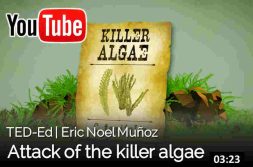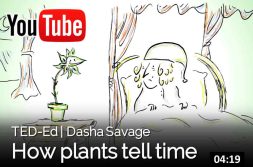Plants
Questions
1. What is your favorite plant? Why?
2. Do you like gardening? What kind of garden would you like to make?
3. Have you ever had any plants in your home?
4. What are some benefits of having plants in your home?
5. What kind of plants can be seen in your city?
6. Have you ever received a flower pot or other small plant as a present?
7. What kind of animals can exist where there are a lot of plants?
8. Are there any plants that people think bring bad luck in your culture?
9. What do plants and people have in common?
10. How do you think plants will change in the future?
11. What do you think of the saying: “The apple doesn’t fall far from the tree.”
Videos
As benign as it may look up close, the tiny seaweed Caulerpa taxifolia can wreak quite a bit of havoc on coastal ecosystems. This super algae is very adaptable; it also grows fast and spreads easily. Eric Noel Muñoz gives the details of this plant’s incredible invasion, shedding light on the risks of introducing invasive species into new ecosystems.
Lesson by Eric Noel Muñoz, animation by Eli Enigenburg.[/show_more]
Lesson by Eric Noel Muñoz, animation by Eli Enigenburg.[/show_more]
Category: Nature & Environment
Morning glories unfurl their petals like clockwork in the early morning. A closing white waterlily signals that it’s late afternoon. And moon flowers, as their name suggests, only bloom under the night sky. What gives plants this
[more]
innate sense of time? Dasha Savage investigates how circadian rhythms act as an internal timekeeper for flora and fauna alike.
Lesson by Dasha Savage, animation by Avi Ofer.
Lesson by Dasha Savage, animation by Avi Ofer.
[less]
Category: Nature & Environment
Hungry Venus flytraps snap shut on a host of unfortunate flies. But, despite its name, flies aren’t the flytrap’s only meal. As long as its prey is roughly the right size and touches two of its hairs within twenty seconds, the
[more]
plant will dine on any insect or spider that comes its way.
Glands in the lobes then secrete enzymes that break the dinner down into a digestible soup. Ten days later, the trap pops open to reveal nothing but a dried out husk.
David Attenborough looks at the extraordinary ends to which animals and plants go in order to survive. Featuring epic spectacles, amazing TV firsts and examples of new wildlife behaviour.
Glands in the lobes then secrete enzymes that break the dinner down into a digestible soup. Ten days later, the trap pops open to reveal nothing but a dried out husk.
David Attenborough looks at the extraordinary ends to which animals and plants go in order to survive. Featuring epic spectacles, amazing TV firsts and examples of new wildlife behaviour.
[less]
Category: Nature & Environment
Tucked away in a corner of London’s Royal Botanic Gardens, there is a very peculiar plant. At first glance, it resembles a stumpy palm tree, but this ancient specimen is incredibly rare. It is, in fact,
[more]
the very last of its kind on Earth. Encephalartos woodii is a cycad, a type of plant that once dominated the planet during the Jurassic Period. Over the millennia, the age of the cycad came to an end. And in the case of Encephalartos Woodii, we may have been left with only one—a single male specimen. This tree is the loneliest bachelor on Earth.
[less]
Category: Nature & Environment



